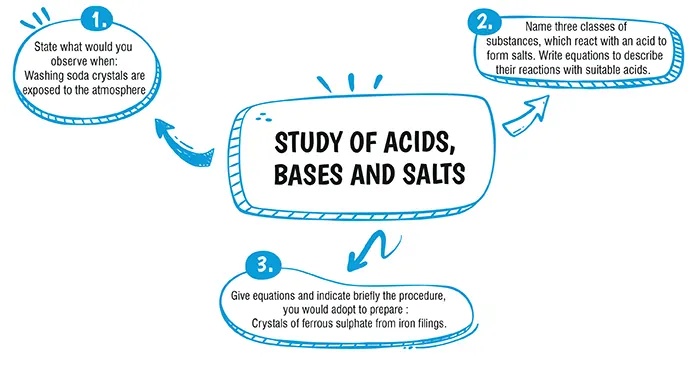Table of Contents

Ans.(b) Temperature of the solution increases.
Explanation:
When acid is added to any base, the temperature of the acid-base reaction rises. This is because this process is exothermic in nature, which means a large amount of heat is evolved, known as heat of neutralisation, causing a temperature to increase.
Ans. (d) Weak acid and strong base
Explanation:
Sodium carbonate is a basic salt because it is derived from a weak acid (carbonic acid) and strong base (sodium hydroxide).
Explanation:
(a) When crystals of washing soda are exposed to air, they lose 9 water molecules of crystallisation and become monohydrate forming a white powder. Thus, shows the phenomenon of efflorescence.
Na_2CO_3.10H_2O \rightarrow{\text{Dry air}}\space \text{Na}_2\text{CO}_3.\text{H}_2O +9\text{H}_2\text{O}
(b) The salt ferric chloride, when exposed to the atmosphere, absorbs water molecules to become moist and shows the phenomenon of deliquescence.
Explanation:
Metals, bases, and metallic carbonates are three distinct types of chemicals that interact with acids to generate salts.
(I) With the formation of zinc sulphate and the release of hydrogen gas, zinc, a metal, reacts with dilute sulfuric acid.
\\Zn + H_2SO_4 → ZnSO_4 + H_2 \\
(ii) To create sodium nitrate and water, the base sodium hydroxide combines with diluted nitric acid.
\\HNO_3 + NaOH → HNO_3 + NaNO_3 + H_2O\\
(iii) When magnesium carbonate, a metallic carbonate, interacts with diluted hydrochloric acid, magnesium chloride water and carbon dioxide gas is released.
Explanation:
(i) 50 cm_3 of diluted sulfuric acid should be placed in a beaker, and it should be heated on a wire gauge. Once the hydrogen effervescence has stopped, add the iron fillings while stirring continuously. Filter the solution to remove any extra iron fillings, and then evaporate the mixture until a saturated solution is created. Separate ferrous sulphate crystals are formed after cooling the solution.
Fe + H_2SO_4 → FeSO_4 + H_2 .
(ii) Take 5 g of zinc carbonate, add diluted sulfuric acid, and heat until all the zinc carbonate is dissolved and the carbon dioxide bubbles have stopped. The solution should be heated and filtered in an evaporating dish until a saturated solution forms. To get the zinc sulphate crystals, let the solution cool.
\\ZnCO_3 + H_2SO_4 → ZnSO_4 + H_2O + CO_2 \\
ZnSO_4 + 7H_2O → ZnSO_4 .7H_2O (Hydrated zinc (II) sulphate)
(iii) Take 5 g of copper (II) sulphate and mix it with water in a beaker. Add sodium carbonate in a strong solution now to this mixture. Copper (II) carbonate precipitates out in a pale blue colour. When you filter a solution, sodium sulphate dissolves in the filtrate and leaves a blue copper carbonate precipitate as a residue on the filter paper.
CuSO_4 + Na_2CO_3 → CuCO_3 + Na_2SO_4 (Light blue colour)
Download Mind Map of this chapter
Download NowWant to Practice Mock Tests of this chapter
Practice NowDownload Important Questions of this chapter
Download Now| Chapter No. | Chapter Name |
|---|---|
| Chapter 1 | Periodic Properties and Variations of Properties |
| Chapter 2 | Chemical Bonding |
| Chapter 3 | Study of Acids, Bases and Salts |
| Chapter 4 | Analytical Chemistry |
| Chapter 5 | Mole concept and Stoichiometry |
| Chapter 6 | Electrolysis |
| Chapter 7 | Metallurgy |
| Chapter 8 | Study of Compounds : Hydrogen Chloride |
| Chapter 9 | Study of Compounds : Ammonia and Nitric Acid |
| Chapter 10 | Study of Compounds : Sulphuric Acid |
| Chapter 11 | Organic Compounds |
| Chapter Wise Important Questions for ICSE Board Class 10 Chemistry |
|---|
| Periodic Properties and Variations of Properties |
| Chemical Bonding |
| Study of Acids, Bases and Salts |
| Analytical Chemistry |
| Mole concept and Stoichiometry |
| Electrolysis |
| Metallurgy |
| Study of Compounds : Hydrogen Chloride |
| Study of Compounds : Ammonia and Nitric Acid |
| Study of Compounds : Sulphuric Acid |
| Organic Compounds |
CBSE Important Questions Class 10
ICSE Important Questions Class 10
CBSE Important Questions Class 10
ICSE Important Questions Class 10